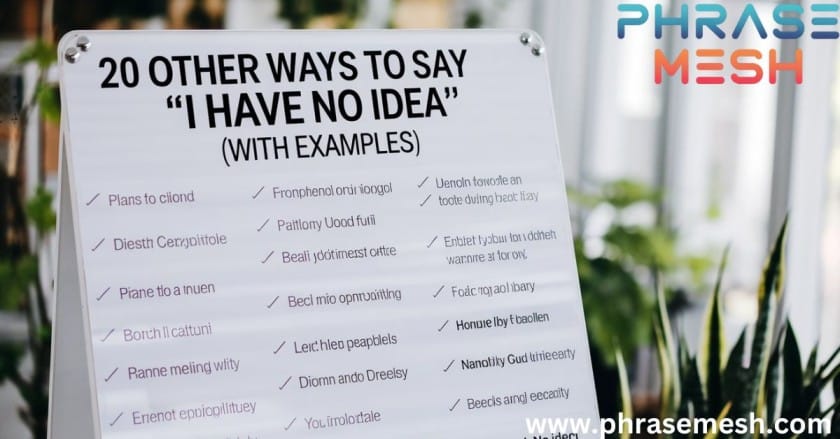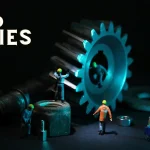When faced with uncertainty, saying “I have no idea” can feel a bit mundane. However, there are countless ways to express that same sentiment with more flair. In this article, we’ll explore 20 other ways to say “I have no idea,” enriching your vocabulary and enhancing your communication skills.
Whether in casual conversations or professional settings, having alternatives at your disposal can help you sound more engaging. So, let’s dive into these creative expressions that convey the same message when you find yourself thinking, “I have no idea!”
Is It Professional to Say ‘I have no idea’?
While the phrase “I have no idea” can be too casual for formal business settings, its appropriateness depends entirely on context and delivery. In relaxed workplace environments or with familiar colleagues, it might be perfectly acceptable.
However, for client meetings, formal presentations, or written communication, it’s better to opt for more polished alternatives like “I’m uncertain about that” or “Let me look into this further.”
What To Say Instead of “I Have No Idea”
Here are all 20 ways to say “I have no idea” :
- I’m afraid I’m in the dark about this matter…
- This is completely beyond me…
- I haven’t the faintest idea…
- I’m feeling rather unsure about…
- No clue, to be honest…
- That remains a bit of a mystery to me…
- I can’t say for certain…
- I don’t know the first thing about…
- I’m completely stumped on this one…
- Not a clue where to begin…
- That’s a bit outside my wheelhouse…
- I’m still getting my bearings on this…
- Let me do some digging first…
- I’m drawing a complete blank…
- That’s uncharted territory for me…
- I’m experiencing some ambiguity here…
- This has me quite puzzled…
- I’m at a bit of a loss…
- That’s a head-scratcher…
- I need to get up to speed on this…
1. “I’m afraid I’m in the dark about this matter…”
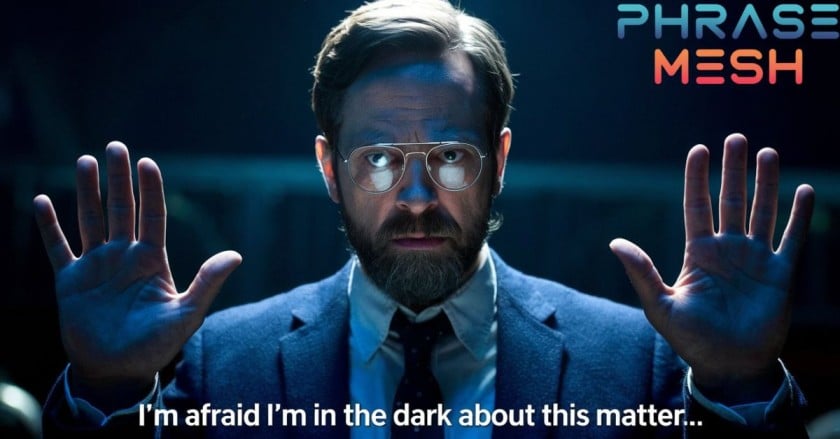
Perfect for professional settings, this phrase acknowledges your unfamiliarity while maintaining sophistication.
Example Email:
Dear Mr. Thompson,
I’m afraid I’m in the dark about the latest changes to the project timeline. Could you please bring me up to speed during our next meeting?
Best regards, Sarah
2. “This is completely beyond me…”
Use this when something genuinely exceeds your expertise or understanding, showing honesty about your limitations.
Example Conversation:
“Hey, can you explain quantum physics to me?” “That’s completely beyond me! I barely passed basic chemistry.”
3. “I haven’t the faintest idea…”
This British-inspired phrase adds a touch of charm to your admission of confusion.
Example Text Message:
“Haven’t the faintest idea where I left my keys! Mind if I swing by to grab the spare set?”
4. “I’m feeling rather unsure about…”
This diplomatic approach shows you’re actively thinking about the situation despite your indecision.
Example Meeting Response:
“I’m feeling rather unsure about the proposed marketing strategy. Could we review the data together?”
5. “No clue, to be honest…”

A casual, straightforward way to express ignorance when formality isn’t necessary.
Example Social Media Comment:
“No clue why my sourdough bread didn’t rise! Any baking experts want to help a newbie out? 😅”
6. “That remains a bit of a mystery to me…”
This playful phrase acknowledges your puzzled state while maintaining engagement in the conversation.
Example Customer Service Response:
“That remains a bit of a mystery to me, but let me connect you with our technical team who can better address your concerns.”
7. “I can’t say for certain…”
Perfect for situations involving ambiguity where you have some knowledge but aren’t completely confident.
Example Professional Response:
Dear Client,
I can’t say for certain when the shipment will arrive due to current supply chain delays. I’ll update you as soon as I receive confirmation.
Best, Michael
8. “I don’t know the first thing about…”
An honest admission of complete unfamiliarity that can open the door for learning opportunities.
Example Job Interview:
“I don’t know the first thing about your proprietary software, but I’m eager to learn and have experience mastering similar systems quickly.”
9. “I’m completely stumped on this one…”
A casual way to express being stuck or puzzled, often used when seeking help.
Example Study Group Chat:
“I’m completely stumped on question 7! Anyone want to walk through it together?”
10. “Not a clue where to begin…”
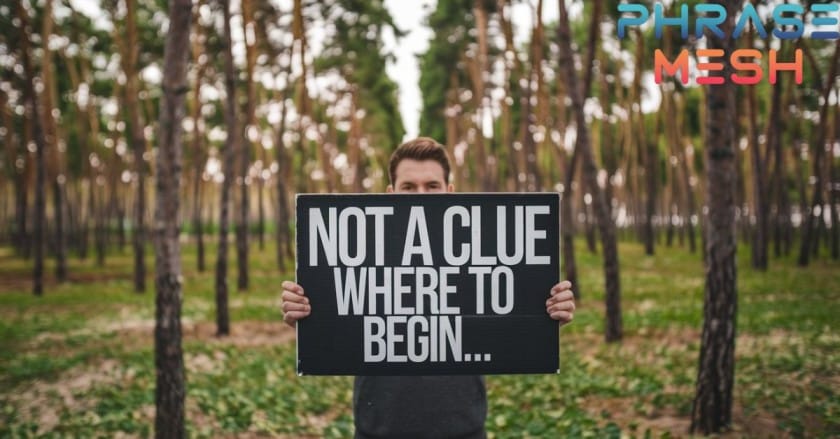
Perfect for expressing complete uncertainty while maintaining a conversational tone.
Example Team Collaboration:
“Not a clue where to begin with this new project, but I’m excited to brainstorm ideas with everyone!”
11. “That’s a bit outside my wheelhouse…”
This modern, professional way shows you’re comfortable with your limitations while maintaining confidence.
Example Team Meeting:
“The technical specs are a bit outside my wheelhouse, but I can collaborate with our engineering team to get you accurate information.”
12. “I’m still getting my bearings on this…”
Perfect when you’re new to a situation or project and need to express your unfamiliarity gracefully.
Example New Job Email:
“Hi Lisa, I’m still getting my bearings on the client management system. Would you mind walking me through the reporting process?”
13. “Let me do some digging first…”
A proactive way to handle your lack of knowledge while promising action.
Example Customer Service Chat:
“Let me do some digging first regarding your warranty claim. Can I put you on a brief hold while I consult with our specialists?”
14. “I’m drawing a complete blank…”
A casual yet honest way to express being stumped without losing credibility.
Example Study Group:
“I’m drawing a complete blank on these calculus formulas. Could we review the basics together?”
15. “That’s uncharted territory for me…”

An elegant way to express unfamiliarity while maintaining a sense of adventure and willingness to learn.
Example Project Discussion:
“Cryptocurrency trading is uncharted territory for me, but I’m eager to research and learn more about it.”
16. “I’m experiencing some ambiguity here…”
A sophisticated way to express confusion in professional settings.
Example Client Email:
“I’m experiencing some ambiguity regarding the project requirements. Could we schedule a brief clarification meeting?”
17. “This has me quite puzzled…”
A thoughtful way to express being confused while maintaining engagement.
Example Problem-Solving Session:
“This programming error has me quite puzzled. Would you mind taking a look at my code?”
18. “I’m at a bit of a loss…”
Shows honesty about your indecision or confusion while keeping things professional.
Example Team Chat:
“I’m at a bit of loss with this client’s feedback. Could we brainstorm some solutions together?”
19. “That’s a head-scratcher…”
A lighthearted way to express being clueless in casual situations.
Example Workplace Conversation:
“That’s a head-scratcher! I’ve never seen the printer malfunction quite like this before.”
20. “I need to get up to speed on this…”
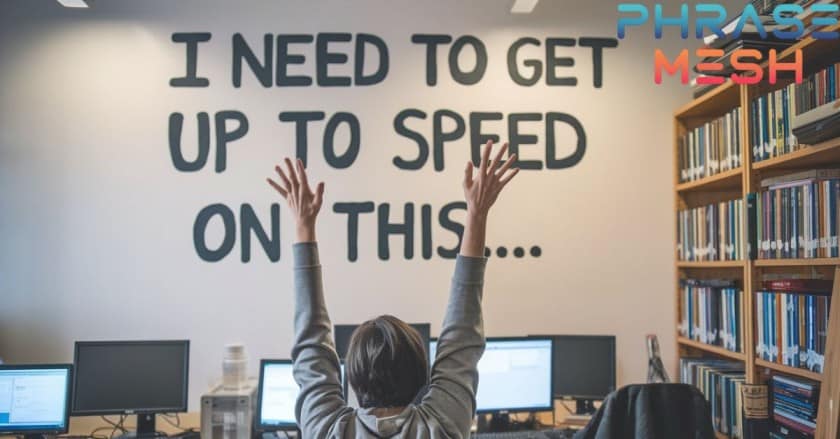
A professional way to acknowledge your lack of knowledge while showing initiative.
Example Manager Email:
“I need to get up to speed on the new compliance regulations. Could you point me toward the relevant training materials?”
Tips for Expressing Uncertainty Professionally
When you find yourself in situations requiring admission of lack of knowledge, remember these key points:
- Always follow up with a solution or request for clarification
- Maintain a positive, learning-oriented attitude
- Be honest about your limitations
- Show willingness to find answers
Context Matters: Choosing the Right Phrase
The level of formality in your response should match your situation:
Formal Settings:
- “I’m afraid I’m in the dark about…”
- “I’m uncertain regarding…”
- “I can’t say for certain…”
Casual Situations:
- “No clue!”
- “That’s beyond me…”
- “Not a clue…”
Professional Development:
- “I haven’t had exposure to…”
- “I’m still learning about…”
- “That’s outside my current expertise…”
Remember, admitting when you don’t know something shows integrity and creates opportunities for growth. Whether you’re dealing with workplace question marks or social situations, having various ways to express uncertainty helps maintain professionalism while staying authentic.
Moving Forward When Uncertain
When expressing your lack of knowledge, always try to:
- Offer to find out more information
- Connect the person with someone more knowledgeable
- Show enthusiasm for learning
- Maintain confidence despite temporary confusion
This approach transforms moments of uncertainty into opportunities for growth and collaboration, making your admission of not knowing something a strength rather than a weakness.
Remember, everyone faces moments of indecision and unfamiliarity. It’s how we handle these moments that sets us apart professionally and personally. Keep these alternatives handy, and you’ll always have a sophisticated way to express uncertainty while maintaining your professional image.
frequently asked questions:
Q1: Will saying “I have no idea” make me look incompetent at work?
Not at all! In fact, admitting what you don’t know can boost your credibility. It’s all about how you phrase it. Try saying “I’ll need to look into that” or “Let me consult with the team” – these responses show honesty and initiative rather than incompetence.
Q2: How can I express uncertainty without undermining my authority as a leader?
Leaders who acknowledge their lack of knowledge often earn more respect. The key is to pair your admission with a solution-oriented approach. Instead of a flat “no idea,” say “While this isn’t my area of expertise, I’ll connect you with someone who can help” or “Let’s explore this together.”
Q3: What’s the best way to tell a client I’m unsure about something?
Always maintain professionalism by using phrases like “Let me confirm those details for you” or “I’ll need to verify that information.” This shows respect for accuracy while keeping your professional image intact. Remember, clients appreciate honesty when it’s paired with a commitment to find answers.
Q4: Should I use different phrases for written versus verbal communication?
Absolutely! Written communication needs more formality. Save your casual “no clue” for in-person chats. In emails or formal documents, opt for phrases like “I’m uncertain regarding this matter” or “This requires further investigation.” Your written words leave a lasting impression.
Q5: How do I avoid sounding clueless when I genuinely don’t know something in a job interview?
Turn your “I don’t know” into an opportunity! Say something like “While I haven’t encountered that specific situation, I’m eager to learn” or “That’s an interesting question – here’s how I would approach finding the answer.” This shows your problem-solving skills and willingness to learn.

